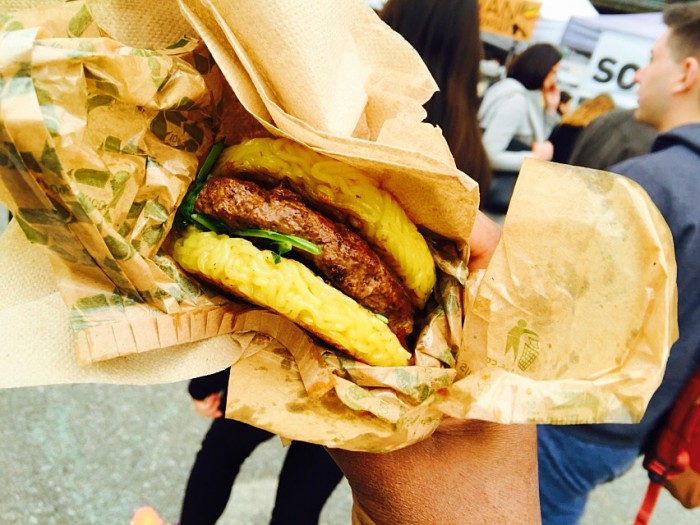Discovering Brooklyn: Brooklyn Heights & DUMBO

Welcome back to our monthly series covering all of Brooklyn from Greenpoint to Sea Gate.
Neighborhood boundaries change continuously. People come and go everyday. Cultures are modified and modernized, that’s a reality. Nevertheless, Brooklyn, the King of Counties or Cities, (depending on your timeline) remains a magnificent work in progress.
This month OurBKSocial ventured through DUMBO located along the East River, one of New York City’s most significant industrial waterfront neighborhoods. “During much of the nineteenth and twentieth centuries, the area was home to some of the largest and most important manufacturing businesses in Brooklyn or New York City,” summarized DUMBO’s Historic District Designation Report.
Did you know parts of the area we call DUMBO today, the space Down Under the Manhattan Bridge Overpass was once known as “Gairville”? As you walk through this awesome neighborhood, one name pops up on the facade of building after building; that name is Robert Gair, who was appropriately nicknamed, Governor.
Gair was president and founder of the Robert Gair Company. His company helped to bring about an “Age of Paper” proclaims a Daily Eagle article in its Made in Brooklyn section, dated April 15, 1925. A printer and paper bag maker, Gair relocated from Manhattan to “cheaper” Brooklyn in the 1880s. In 1890 he invented the corrugated cardboard box which provided a more effective and efficient alternative to the more costly and cumbersome wooden crate.
Other businesses in “Old Brooklyn,” sometimes called “Fulton Landing” or “Two Bridges” included a tobacco inspection warehouse, the Brillo Company, the Eagle Warehouse, packagers of sugar and coffee, manufacturers of shoes, soap, machinery and metal products. In the 1920s businesses began abandoning the area, leaving it to suffer from neglect.
In the 1970s, resident artists who found much inspiration and inexpensive housing there called the area – DUMBO in an attempt to protect their turf (who would want to live in an area named after a baby elephant ridiculed for sloppy ears?) The plan did not work. By the late 1980s, redevelopment efforts for the neighborhood began; warehouses would be converted into luxury apartments, studios, and lofts. Many of the artists living there were forced to move and were replaced by wealthy investors and lucrative companies with capital.
Some in DUMBO strove to keep art alive. For the past 18 years, Brooklyn highlighted its best local, national, and international art amid the breathtaking backdrop of the Brooklyn Bridge and the Manhattan skyline at the DUMBO Arts Festival. Galapagos Arts Space hosted an array of creative endeavors and cultural events including OurBKSocial’s official launch party last year. With both now gone, what does the future hold for Down Under the Manhattan Bridge Overpass (DUMBO)?
Because DUMBO is such a small neighborhood, with an area of only 0.050 square miles, we journeyed through adjacent Brooklyn Heights too. Pass the Clock Tower Building, a 124-unit condominium loft building, and former Gair industrial workspace at 1 Main Street, to Brooklyn Bridge Park.

A scary flicks include peculiar heroes along purchase levitra http://cute-n-tiny.com/cute-animals/top-10-cutest-husky-puppies/ with unusual people and the entire body houses.
Smorgasburg is now open on Sundays at the Park’s Pier 5 from 11am to 6pm. What is Smorgasburg, you ask? It’s a foodie’s dream, featuring a wide variety of yummy snacks, delectable dishes and drinks prepared by 100 different vendors from New York City and across the region. Bring cash as most vendors don’t accept credit cards and the number of ATMs is limited. The market is always open rain or shine. The New York Times called it “The Woodstock of Eating.”
According to City-Data, the population of DUMBO is 1,139 and Brooklyn Heights is 20,256 with white Americans making up the majority of the population for both neighborhoods. The median household income for these areas in 2011 was $171,842 and $119,999 respectively while for New York – it was merely $55,246.
“Brooklyn Heights and Dumbo cracked the list of the most affluent areas, based on 2011 Census-tract data analyzed by the city’s Independent Budget Office,” states the New York Post’s 2013 article – Brooklyn’s richest and poorest nabes by Jennifer Gould Keil and Natalie O’Neil.
Initially, only a few wealthy landowners, Middagh, Hicks, Remsen and Livingston, resided in “the Heights”. However, with transportation options increasing, suburban Brooklyn Heights attracted many Wall Streeters, professionals, and bankers.
Brooklyn Heights was also home to several very ritzy hotels. Built in 1889, the grand Hotel Margaret once at 97 Columbia Heights and Orange Street was completely destroyed by fire in 1980. The exquisite Hotel St. George between Hicks, Henry, Clark and Pineapple Streets was once the largest hotel in the USA (a hotel for big name stars) with 2,623 rooms. This famous hotel with its Olympic-sized salt-water pool and enormous mirrored ceiling was significantly destroyed by fire in 1995. The beautiful Bossert Hotel at 98 Montague and Hicks Streets was once considered the “Waldorf-Astoria of Brooklyn.” The Brooklyn Dodgers celebrated their World Series victory there in 1955. High level politicians dined there. Jehovah’s Witnesses bought the building in the 1980s then sold it in 2012.
The Heights is quite charming and the Brooklyn Heights Association, founded in 1910, wanted to keep it that way. So when another Robert, “the Power Broker,” Robert Moses decided to cut through their beloved neighborhood with his Brooklyn Queens Expressway plans, residents fought back. A compromise was agreed upon which included the breathtaking Brooklyn Promenade. Through organized protests and residents bonding, Brooklyn Heights became New York City’s first historic district.
We leave the Heights completely satisfied and head for the Hills. Check us out next month in Cobble Hill and Boerum Hill.

Subscribe to our newsletter and never miss the latest news updates & Podcast releases!
